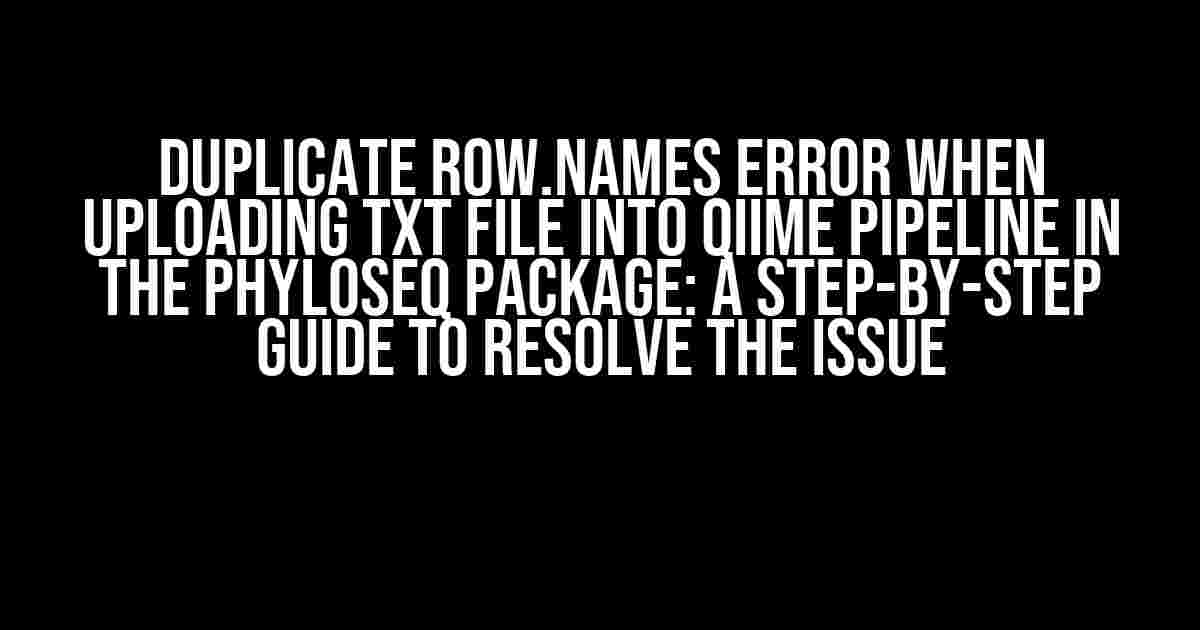Are you stuck with the frustrating “duplicate row.names” error when trying to upload a txt file into the QIIME pipeline using the phyloseq package? Worry not! This comprehensive guide will walk you through the troubleshooting process to resolve this issue and get your research back on track.
Understanding the Error: What are Duplicate Row Names?
In R, the programming language used in phyloseq, each row in a data frame must have a unique identifier or name. When you import a txt file containing duplicate row names, R throws an error to prevent conflicts in data identification. This error message is particularly common when working with QIIME pipeline files, which often contain identical sample IDs.
Why Does the Error Occur?
The duplicate row.names error can occur due to various reasons:
- Sample IDs are not unique in the original QIIME pipeline file.
- The txt file contains unnecessary columns or duplicate entries.
- The file was not properly formatted during the export process.
Step-by-Step Solution: Resolving the Duplicate Row Names Error
Follow these instructions to resolve the duplicate row.names error and successfully upload your txt file into the QIIME pipeline using phyloseq:
Step 1: Inspect the txt File
Open the txt file in a text editor or spreadsheet software (e.g., Microsoft Excel, Google Sheets) and:
- Check for duplicate sample IDs.
- Verify that each row has a unique identifier.
- Remove any unnecessary columns or duplicate entries.
Step 2: Remove Duplicate Row Names in R
In R, use the following code to remove duplicate row names:
# Load the txt file into R
data <- read.table("your_file.txt", header = TRUE)
# Remove duplicate row names
data <- data[!duplicated(row.names(data)), ]
# Verify the row names are unique
any(duplicated(row.names(data)))
This code reads the txt file into R, removes duplicate row names, and checks if there are any remaining duplicates.
Step 3: Reformat the txt File
If the error persists, try reformatting the txt file:
- Save the file in a different format (e.g., CSV, TSV).
- Check the file’s encoding and ensure it’s set to UTF-8.
Step 4: Upload the Formatted File into phyloseq
Now, upload the reformatted file into phyloseq using the following code:
# Load the phyloseq package
library(phyloseq)
# Upload the reformatted file
ps <- import("your_file.txt", "otu_table")
If the file is uploaded successfully, you should see a confirmation message indicating that the data has been imported.
Common Pitfalls and Troubleshooting Tips
When working with QIIME pipeline files and phyloseq, keep in mind:
- Ensure consistent formatting throughout the file.
- Verify that sample IDs are unique and match the corresponding metadata.
- Check for any unnecessary or duplicate columns.
Conclusion
By following these step-by-step instructions, you should be able to resolve the duplicate row.names error and successfully upload your txt file into the QIIME pipeline using phyloseq. Remember to carefully inspect your file, remove duplicate row names, and reformat the file if necessary. Happy analysis!
| Common Error Messages | Solution |
|---|---|
| Error in row.names(.Data) … duplicate ‘row.names’ are not allowed | Remove duplicate row names using the code provided in Step 2. |
| Error: invalid ‘row.names’ length | Verify that each row has a unique identifier and check for duplicate entries. |
Keywords: Duplicate row.names error, QIIME pipeline, phyloseq package, txt file upload, R, microbiome analysis.
Frequently Asked Question
Are you stuck with the pesky “duplicate row.names” error when uploading a txt file into the QIIME pipeline in the phyloseq package? Fear not, dear researcher! We’ve got the solutions to your most pressing questions.
What causes the “duplicate row.names” error in phyloseq?
This error typically occurs when there are duplicate sample names in the txt file, which is not allowed in phyloseq. It’s a simple mistake, but one that can be frustrating to troubleshoot!
How can I identify the duplicate row names in my txt file?
Easy peasy! You can use the `duplicated()` function in R to identify the duplicate row names. Simply load your txt file into R, and run `duplicated(rownames(your_data))`. This will return a logical vector indicating which rows are duplicated.
Can I remove duplicate row names using R?
Yes, you can! Use the `duplicated()` function in conjunction with the `rownames()` function to remove the duplicates. For example: `rownames(your_data) <- ifelse(duplicated(rownames(your_data)), paste0(rownames(your_data), "_dup"), rownames(your_data))`. This will append "_dup" to the duplicate row names, making them unique.
What if I have a large dataset and removing duplicates is not feasible?
Don’t worry, we’ve got you covered! In this case, you can use the `make.names()` function in R to make the row names unique. This function will append a suffix to the duplicate names, making them unique. For example: `rownames(your_data) <- make.names(rownames(your_data), unique = TRUE)`. Easy!
Are there any other common issues that can cause errors when uploading a txt file into phyloseq?
Yes, another common issue is having non-unique column names. Phyloseq requires unique column names, so make sure to check for duplicates before uploading your file. You can use the `colnames()` function in R to check for duplicate column names, and the `make.names()` function to make them unique.
